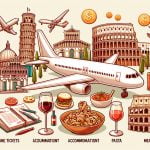Planning a trip to Italy? It’s essential to know how to handle money when traveling in Italy, from understanding the currency to knowing where and how to exchange your money. In this article, we’ll cover everything you need to know about managing your finances while exploring this beautiful country.
We’ll provide tips on exchanging currency, using ATMs and debit/credit cards, budgeting for your trip, staying safe with your cash, avoiding tourist traps, understanding tipping etiquette, dealing with currency conversion, and preparing for emergencies. Whether you’re a first-time traveler or a seasoned globetrotter, these insights will help you make the most of your Italian adventure.
When traveling in Italy, it’s crucial to understand the difference between the Euro and the American Dollar and how it can affect your spending. Knowing how to navigate through foreign currency exchange is an important aspect of international travel.
Finding the best places and rates for exchanging currency in Italy can save you time and money during your trip. Furthermore, using ATMs and debit/credit cards also comes with its own set of fees and accessibility considerations that we will address in this guide.
Budgeting plays a significant role in making sure that you don’t overspend while exploring Italy’s rich culture and heritage. Not only that but also knowing how to carry cash safely and protect yourself from potential theft is vital for a worry-free holiday.
In addition to this article on managing money while traveling in Italy, we’ve lined up tips on saving money when dining out or shopping as well as understanding when and how much to tip according to Italian etiquette. Lastly, we’ll walk you through handling emergency situations if you happen to lose your money during your travels in Italy.
Tips for Exchanging Currency
When traveling to Italy, it’s important to have the local currency on hand to pay for expenses such as food, transportation, and souvenirs. Understanding how to exchange currency and where to find the best rates can save you time and money during your trip.
Best Places to Exchange Currency
When it comes to exchanging currency in Italy, it’s best to avoid airports and hotels where the exchange rates tend to be less favorable. Instead, look for local banks or authorized currency exchange offices. These places often offer better rates with lower fees, allowing you to get more euros for your money.
Understanding Exchange Rates
Before exchanging your money, take the time to understand the current exchange rates between the euro and your home currency. Keep an eye on fluctuations in the market so you can make informed decisions about when to exchange your money. Consider using online tools or apps that provide real-time exchange rate information.
Tips for Getting the Best Rates
To ensure you get the best possible exchange rates, consider exchanging a larger sum of money at once rather than small amounts multiple times. Additionally, try to avoid exchanging money in tourist-heavy areas or areas near popular attractions, as these locations often have higher fees and less competitive rates.
By following these tips for exchanging currency in Italy, you can maximize your travel budget and make sure you have enough euros on hand for a smooth and enjoyable trip. Understanding where to find favorable rates and how to navigate currency conversion will help you make the most of your travel experience while in Italy.
Using ATMs and Debit/Credit Cards
When traveling in Italy, it’s important to understand how to handle money in terms of using ATMs and debit/credit cards. While carrying cash is essential, having access to your bank accounts through ATMs and using plastic can be convenient. Here are some tips on how to handle money when traveling in Italy:
- Research Before You Go: Before arriving in Italy, it’s crucial to inform your bank about your travel plans. Some banks may put a hold on your card if they see transactions from a foreign country without prior notice. Also, find out if your bank has partnerships with any Italian banks to minimize withdrawal fees.
- ATM Accessibility: ATMs are widely available throughout Italy, especially in major cities and tourist areas. However, keep in mind that in rural areas or smaller towns, ATM accessibility may be limited.
- Understand Fees: Using an ATM card abroad can come with fees such as foreign transaction fees and currency conversion fees. It’s important to inquire about these fees with your bank beforehand so you’re aware of the potential costs.
- Credit Card Usage: Major credit cards like Visa and Mastercard are widely accepted in Italy, especially at hotels, restaurants, and larger retailers. Just like with ATMs, it’s essential to know the foreign transaction fees associated with using your credit card abroad.
By being prepared and informed about how to handle money when traveling in Italy using ATMs and debit/credit cards, you can make sure you have access to funds when you need them while minimizing unnecessary expenses.
Budgeting for Your Trip
When planning for your trip to Italy, it’s crucial to have a clear understanding of the costs and expenses you’ll encounter. Whether it’s accommodation, food, transportation, or sightseeing, having a solid budget in place will ensure that you can make the most of your travels without overspending.
One of the first steps in budgeting for your trip to Italy is to research the average costs in various cities and regions. For example, while cities like Rome and Milan may have higher prices for hotels and dining, smaller towns and villages could offer more affordable options. Make sure to factor in expenses such as attraction fees, public transportation, and any additional activities you plan on doing during your stay.
Another important aspect of budgeting is keeping track of your spending as you travel. Consider using a travel budget app or simply keeping a travel journal where you record all of your expenses. This will help you stay accountable and avoid overspending.
Finally, when setting your budget for Italy, it’s essential to consider unexpected expenses and emergencies. Setting aside some extra funds for unforeseen circumstances like lost luggage or medical emergencies can provide peace of mind during your travels.
| City | Average Daily Cost |
|---|---|
| Rome | $150-$200 |
| Florence | $120-$150 |
| Venice | $180-$220 |
| Milan | $200-$250 |
Safety Tips for Carrying Cash
When traveling in Italy, it’s important to be mindful of how you handle your cash to protect yourself from theft or loss. Here are some tips for carrying cash and ensuring the safety of your money during your travels:
- Use a money belt or hidden pouch: Keep your cash, cards, and other valuables in a concealed pouch or belt worn under your clothing to prevent pickpocketing.
- Divide your money: Instead of keeping all your cash in one place, divide it among different pockets and bags to minimize the risk of losing everything at once.
- Avoid flashy displays: Refrain from displaying large amounts of cash in public as it may attract unwanted attention. Use discreet methods when paying for purchases.
It’s also essential to familiarize yourself with the common scams and theft tactics that tourists may encounter in Italy. Being knowledgeable about these schemes can help you stay vigilant and protect your money.
Familiarize Yourself With Common Scams
- Distraction techniques: Be cautious of individuals who approach you with unexpected distractions, such as spilling something on you, as these could be attempts to steal from you.
- ATM skimming: When using ATMs, inspect the machine for any unusual devices or signs of tampering that could indicate a skimming attempt.
- Street vendors and counterfeit money: Take extra care when purchasing items from street vendors, as some may try to pass off counterfeit currency.
By following these safety tips and staying alert while handling your money in Italy, you can enjoy a worry-free travel experience without any financial setbacks.
Avoiding Tourist Traps
When traveling in Italy, it’s important to be mindful of tourist traps that can quickly deplete your travel budget. From overpriced restaurants to high-end souvenir shops, these traps can easily lead to overspending. To avoid falling into these pitfalls, here are some money-saving strategies for dining and shopping in Italy.
Seek Out Local Eateries
One of the best ways to save money on dining in Italy is to seek out local eateries that offer authentic Italian cuisine at more affordable prices. Avoid restaurants located near major tourist attractions, as they tend to be more expensive and cater to tourists. Instead, wander off the beaten path and look for smaller, family-owned trattorias and osterias where locals dine.
Shop at Local Markets
Instead of purchasing souvenirs from high-priced tourist shops, consider shopping at local markets where you can find unique items at more reasonable prices. Italian markets are known for their artisanal products such as leather goods, ceramics, and handmade accessories. Not only will you get a better deal by shopping at these markets, but you’ll also have the opportunity to support local artisans and businesses.
Take Advantage of Happy Hour and Aperitivo Specials
In many Italian cities, especially in major tourist destinations like Rome, Florence, and Venice, you’ll find bars and restaurants offering “aperitivo” specials during happy hour. This typically includes a drink along with unlimited access to a buffet of snacks or small dishes. Taking advantage of these specials not only allows you to enjoy a delicious meal but also saves you money on dining expenses.
By implementing these money-saving strategies for dining and shopping, travelers can make the most of their budget while experiencing all that Italy has to offer without breaking the bank. Remembering how to handle money when traveling in Italy is essential for enjoying a stress-free vacation without worrying about overspending.
Understanding Tipping Etiquette
When traveling in Italy, it’s important to understand the tipping etiquette to avoid any social faux pas. In general, tipping is not as common in Italy as it is in other countries like the United States. However, there are certain situations where leaving a tip is appreciated. For example, if you receive exceptional service at a restaurant, it is customary to leave a small tip of 5-10% of the total bill.
It’s important to note that some restaurants may include a “servizio” or service charge on the bill, especially in touristy areas. In this case, leaving an additional tip is not necessary. When it comes to taxi drivers, rounding up the fare is customary but not mandatory. However, if they help with your luggage or provide exceptional service, a small tip is appreciated.
One important thing to keep in mind when tipping in Italy is that cash is preferred. Many establishments may not have the option to add a tip onto a credit card payment. Additionally, always give your tip directly to the person who provided the service rather than leaving it on the table or handing it over with your payment.
When understanding how much to tip in Italy, it’s also helpful to know that workers in Italy are paid differently than those in the U.S. so tipping culture reflects this difference. Overall, understanding and respecting Italian tipping customs can enhance your travel experience and ensure smooth interactions with locals.
| Tipping Etiquette | Guidelines for Tipping |
|---|---|
| Restaurants | 5-10% of total bill for exceptional service |
| Taxi Drivers | Round up fare; additional for exceptional service |
| Cash Preferred | Give tips directly to service providers; cash preferred over credit card tips |
Dealing With Currency Conversion
When traveling in Italy, it is important to understand how currency conversion works, including exchange rates and fees. The official currency in Italy is the Euro, so if you are coming from the United States with American Dollars, you will need to convert your money. It’s essential to familiarize yourself with the current exchange rate between the Euro and the Dollar before your trip, so you have an idea of how much your money is worth.
One of the best ways to handle money when traveling in Italy is by exchanging currency at reputable places that offer fair rates and low fees. Banks and currency exchange offices are the most reliable places to exchange money, but be cautious of using exchange services at airports or tourist areas, as they often charge higher fees and provide less favorable rates.
Researching and comparing exchange rates offered by different establishments can help you make a more informed decision on where to convert your money.
Additionally, when using credit or debit cards in Italy, it’s important to be aware of any foreign transaction fees that may apply. Some banks charge a fee for each international transaction made with your card, so it’s best to inquire about these fees before your trip.
Always notify your bank about your travel plans to avoid any issues with card usage while abroad. By understanding exchange rates and fees and selecting the most cost-effective options for currency conversion, you can better manage your finances during your travels in Italy.
Emergency Preparedness
In conclusion, handling money when traveling in Italy requires careful planning and consideration. Understanding the currency exchange, best places to exchange currency, and fees associated with using ATMs and debit/credit cards are essential for a smooth financial experience while abroad. Additionally, budgeting for your trip and being mindful of expenses can help you stay on track financially.
It is important to be prepared for unforeseen circumstances, such as losing your money while in Italy. Knowing how to access emergency funds or having a backup plan in place can provide peace of mind during your travels. By familiarizing yourself with tipping etiquette and avoiding tourist traps, you can also save money on dining and shopping.
Overall, traveling in Italy can be a rewarding experience both culturally and financially. By being informed about how to handle money when traveling in Italy, you can make the most of your trip without breaking the bank. Whether it’s understanding exchange rates or knowing what to do in case of an emergency, proper preparation is key to enjoying a stress-free travel experience.
Frequently Asked Questions
Is It Better to Carry Cash or Card in Italy?
In Italy, it is generally better to carry both cash and a card. Cash is widely accepted, especially in smaller establishments or for transactions with street vendors. However, having a card can be useful for larger purchases or emergencies.
Should I Exchange Money Before I Travel to Italy?
It is advisable to exchange some money before traveling to Italy, especially if you are arriving late at night or on a weekend when exchange offices may be closed. Having some euros on hand upon arrival can help cover initial expenses like transportation or food.
What Is the Best Way to Take Money to Italy?
The best way to take money to Italy is by using a combination of methods. It’s recommended to bring some euros in cash for immediate needs, along with a debit or credit card for larger expenses or emergencies. Additionally, consider carrying a travel money card as another option for accessing funds while in Italy.

I’m a passionate traveler, writer, and Italophile. My fascination with Italy’s history, art, and culture has led me on countless adventures across the Italian landscape. Through “I Live Italy,” I share my love for this extraordinary country and aims to inspire others to explore its boundless beauty.





